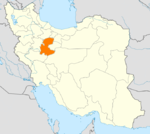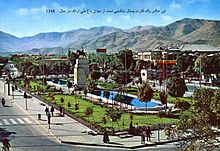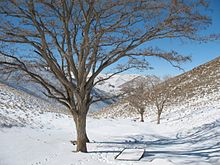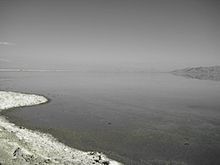- Arak, Iran
-
For the administrative subdivision, see Arak County.
Arak
اراك— city — Coordinates: 34°05′30″N 49°41′21″E / 34.09167°N 49.68917°ECoordinates: 34°05′30″N 49°41′21″E / 34.09167°N 49.68917°E Country  Iran
IranProvince Markazi County Arak Bakhsh Central Population (2006) – Total 438,338 Time zone IRST (UTC+3:30) – Summer (DST) IRDT (UTC+4:30) Arak (Persian: اراك, also Romanized as Arāk and ‘Irāq; formerly, Solţānābād and Sultānābād)[1] is a city in and the capital of Markazi Province, Iran. At the 2006 census, its population was 438,338, in 121,597 families.[2]
Contents
History
Arak is built on the ruins of a small town called Daskerah, which was destroyed during the Mongol invasion of Persia.
Modern Arak is a relatively new city on fertile lands, reestablished in 1795 with primary construct ending in 1852. The new city was founded and financed during the Qajar era by an Iranian Georgian Yusef Khan Gorji, a pro-Iranian Georgian warlord given refuge by Agha Mohammad Khan (Persian: محمد خان قاجار) (1742–1797) following a territorial dispute with his cousins who were supported by Imperial Russian Empress Catherine the Great. His family calls him.
In the period between 1795 and 1797, Yusef Khan-e Gorji, renamed Yusef Khan-e Sepahdar by the Shah, settled his army in the fertile though poorly-controlled territory that would become modern Arak. Hostile tribes in this region had operated autonomously from Qajar rule. With the Persian Shah’s approval, Yusuf Khan diverted the main river to drive out the hostiles and built the Soltan Abad fortress, or Baladeh, a war fortress to act as a buffer and serve as the foundation of what would become modern Arak.
Yusuf Khan’s organized military force was established in this region aptly named (or more accurately, re-named) "Persian Iraq" (Iraq-e ajam) (عراق عجم) from ancient times meaning 'smooth land'. According to historians, Yusef Khan built Arak from his own personal income and with the aid of affluents.
The town would remain a military base and fortress until 1892. The Soltan Abad fortress had a thick wall surrounded by great moats, 7 meters deep. Eight towers were constructed around the town and the governmental building was established in its northern part.
In 1891 deputy governor, Etemadol Saltaneh Mirza Hasan, repaired all of the shops, gardens and all government buildings in Soltan Abad’s greater town and with the owners of industries from other towns, settled in Arak. Large portions of the town were annexed as personal property to the pre-existing army commanders though these were ultimately turned over to the state from 1918-1922.
The evolution of the modern town name is from Soltan Abad fortress, to Sultan Abad, to Iraq-e Ajam (Persian Iraq), and finally to its current name, Arak, in 1938.
Historical buildings and architecture
- Hammame Charfasl (Four-Season Bath)
- Baghe Nezam Lashgar (Esmaeili)
- Saraye Mehr (In the Bazaar)
- Sultan Abad Museum
- Koohe mostofi
Attractions
- Park Amirkabir
- Park Jangali
- Bagh-e-Vahsh (The zoo was first opened to investigate the pollution from the industries mainly from the Aluminium plant on animals)
- Pol-e-doab (An old mud based bridge built over sharra river)
- Darreh-e-Gerdou (Famous for its walnut trees and ranges, it is very popular place for morning exercises and weekend getaways)
- Museum of Artifacts
- Mojtama-e Tafrihi-i.e. Amirkabir
Location and climate
Arak is located at 34°05′N 49°42′E / 34.08°N 49.7°E . The city is surrounded by mountains in the south, west, and east. Arak is located in adjacency two important cities: Qom and Isfahan. Its average altitude is 1750m above sea level and is 260 km from the capital, Tehran.
Climate
Arak has a continental Mediterranean climate (Köppen climate classification Csa) that is, in general, relatively cold and dry. Its weather is warm and dry in summer, windy and cool in autumn, cold and snowy in winter, and mild in spring. The maximum temperature may raise up to 35 degrees Celsius in summer and may fall to below -25 degrees Celsius in winter. The average rainfall is around 300mm and the annual relative humidity is 50%.[citation needed]
Climate data for Arak Month Jan Feb Mar Apr May Jun Jul Aug Sep Oct Nov Dec Year Average high °C (°F) 4.2
(39.6)6.8
(44.2)13.5
(56.3)19.6
(67.3)25.6
(78.1)32.6
(90.7)35.8
(96.4)34.9
(94.8)30.8
(87.4)23.1
(73.6)14.8
(58.6)7.6
(45.7)20.78
(69.40)Average low °C (°F) −5.7
(21.7)−3.8
(25.2)2.0
(35.6)7.0
(44.6)11.0
(51.8)15.3
(59.5)18.8
(65.8)17.5
(63.5)13.0
(55.4)7.8
(46.0)2.6
(36.7)−2.2
(28.0)6.94
(44.50)Precipitation mm (inches) 54.7
(2.154)47.6
(1.874)53.1
(2.091)53.4
(2.102)31.9
(1.256)1.5
(0.059)0.6
(0.024)1.1
(0.043)0.7
(0.028)18.5
(0.728)31.6
(1.244)51.0
(2.008)345.7
(13.61)Avg. precipitation days 10.8 9.8 11.4 9.4 7.1 1.1 0.9 0.6 0.6 4.3 6.1 8.9 71 Source: World Meteorological Organisation (UN) [3] Industries
Arak is one of the main industrial cities of Iran, possessing many plants for heavy industries especially for the metal and machinery industries, including:
- Machin Sazi Arak (MSA) and AzarAb factories (producing heavy machinery such as boilers and chemical reactors)
- Wagon Pars (train manufacturer)
- Iranian Aluminium Company (IrAlCo)
- HEPCO (heavy road construction vehicles)
- Navard Aluminum
- Iran Combine Manufacturing Company (Combine-Sazi-e Iran)
- Arak Oil Refinery Company [4]
- Arak Petrochemical Company (ARPC) [5]
- Heavy Water production plant [6]
- Power plant and a low power (less than 40 megawatts) heavy water nuclear power plant (IR-40).[7]
Universities
- University of Arak
- Arak University of Medical Sciences
- Amirkabir University of Arak
- Iran University of Science and Technology,Arak Campus
- Islamic Azad University of Arak
Demography
There are a diversity of Iranian ethnicities living in the city. They include Persians and Lurs. Also, in the Safavid era, Armenians had settled in the Arak area,[8] but their numbers have declined due to migration to Tehran.
Agriculture and handicrafts
The main agricultural products are grain, barley, and fruits which are grape, apple, walnut and almond. Arak also exports hand-knotted carpets which are generally referred to as Sarouk (Saruk or Sarough) rugs. Sarouk is a small village outside of Arak, and its name is used when exporting carpets so consumers do not get confused with rug from Iraq.
Notable people from Arak
Statesmen and politicians:
- Ghaem Magham Farahani (1779–1835), Prime Minister, was born in Arak, in a Northern region named Farahan.
- Amir Kabir (1807 - January 11, 1852), Prime Minister, was born in Arak, in a northern region known as Hezaveh.
- Morteza Gholi Bayat (1890–1958), Prime Minister (1944–45), was born in Arak.
- Mohammad Mosaddegh(1882–1967), Prime Minister (May 1951-July 1952; August 1952-53), was born in Tehran; his father was from Ashtiyan, north eastern region of Arak.
- Ata'ollah Mohajerani, He was one of Khatami's cabinet ministers during the power of reformists.
Artists and literary figures:
- Parvin E'tesami (1907–1941), the Iranian Poet, was born in Tabriz in 1907; her father was from Ashtiyan, north eastern region of Arak.
- Behjat Sadr (1924–2009), Iran's first eminent female Painter.
- Kader Abdolah, the Dutch Writer Laureate.
- Jahangir Razmi, the 1980 Pulitzer Prize Winner Photographer.
Sportsman:
- Mansour Bahrami, famous tennis player.
Media/Television:
- Reza Badiyi, well known for directing episodes of many popular (and quite distinct) American television series, including Get Smart, Mission: Impossible, Hawaii Five-O, The Incredible Hulk, Mannix, The Six Million Dollar Man, Starsky and Hutch, The Rockford Files and Police Squad, The Mary Tyler Moore Show, Falcon Crest, Cagney and Lacey, Dr. Quinn, Medicine Woman, Star Trek: Deep Space Nine, Buffy the Vampire Slayer (the episode "Out of Mind, Out of Sight"), Nikita, Sliders and Baywatch, amongst others.
References
- ^ Arak, Iran can be found at GEOnet Names Server, at this link, by opening the Advanced Search box, entering "-3053519" in the "Unique Feature Id" form, and clicking on "Search Database".
- ^ "Census of the Islamic Republic of Iran, 1385 (2006)" (Excel). Islamic Republic of Iran. http://www.amar.org.ir/DesktopModules/FTPManager/upload/upload2360/newjkh/newjkh/00.xls.
- ^ "World Weather Information Service – Klaipėda". United Nations. May 2011. http://worldweather.wmo.int/114/c01443.htm. Retrieved 1 January 2011.
- ^ [1][dead link]
- ^ [2][dead link]
- ^ 34°22′12″N 49°14′42″E / 34.370°N 49.245°E
- ^ [1]34°22′24″N 49°14′27″E / 34.37341°N 49.24078°E
- ^ [3]
External links
- Arãk entries in the Encyclopaedia Iranica
 Markazi Province
Markazi ProvinceCapital Arak
Counties and Cities AshtianFarahan CountyFarmahin · SaruqiKhomeyn CountyKhomeyn · Qurchi BashiKhondab CountyKhondabKomijan CountyKomijan · MilajerdSights Chal nakhjir cave, Delijan · Khorheh · Atashkoh fire temple, Nimvar · Mausoleum of Mahmoud Hessaby ,Tafresh · Arak's grand Bazzar · Mahallat's flower and plant festival · Aveh ancient cite, Saveh · Chaharfasl bath museum, Arak · Hezaveh village · Jameh Mosque of Saveh · Panzdah khordad dam · Emarat lake, Shazand · Azadkhan cave, Mahallat · Mostufi-al-mamalek's castle, Ashtian · Dudahak caravansary, Delijan · Naragh's historical complex · Sepahdar school, Arak · Sheshnaveh mosque · Mahdiabad's Yakhchal ·Categories:- Arak
- Arak County
- Cities in Iran
- Cities in Markazi Province
- Iranian provincial capitals
Wikimedia Foundation. 2010.





